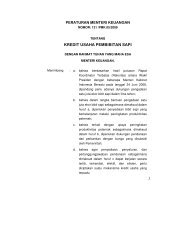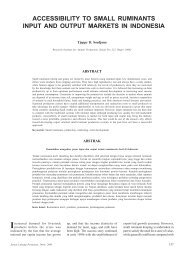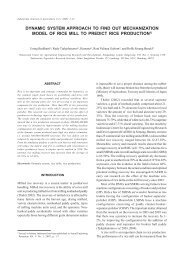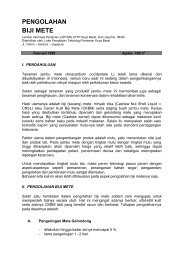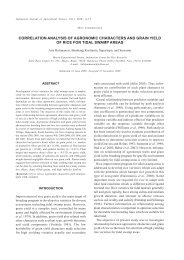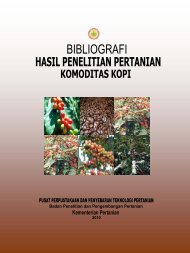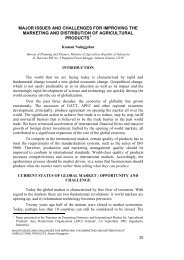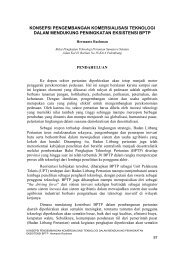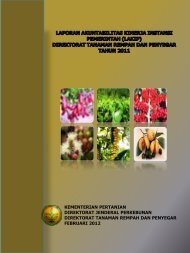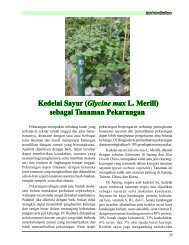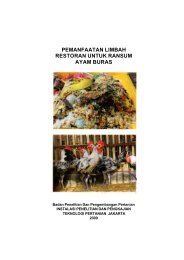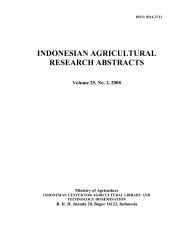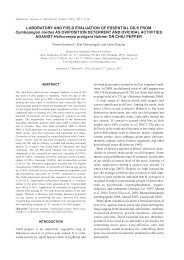IARA Vol. XXV No. 1 Year. 2008 (pdf, 1000 kb) - Pustaka Deptan
IARA Vol. XXV No. 1 Year. 2008 (pdf, 1000 kb) - Pustaka Deptan
IARA Vol. XXV No. 1 Year. 2008 (pdf, 1000 kb) - Pustaka Deptan
Create successful ePaper yourself
Turn your PDF publications into a flip-book with our unique Google optimized e-Paper software.
<strong>Vol</strong>. 25, <strong>No</strong>. 1, <strong>2008</strong><br />
Indonesian Agricultural Research Abstracts<br />
A field experiment using a paired treatment comparison was conducted at Bojong Nagara Village, Ciledug<br />
Subdistrict, Cirebon District, West Java (approx. 5 m asl) from June until December 2002. The purpose of<br />
this study was to compare the technique and economic feasibility of IPM technology found by Indonesian<br />
Vegetables Research Institute with farmer's system on shallot and hot pepper in relay planting system. The<br />
experiment used comparison design with four replications. The plot size was 100 m 2 . The results on<br />
shallot showed that IPM implementation gave more economically advantages than the farmer's system,<br />
because R/C ratio on IPM plot was 1.47 and R/C ratio on farmer's plot was 0.84, respectively. On hot<br />
pepper, the plant damage in IPM plot was lower than that in farmer's plot, but the yield on IPM plot was<br />
lower than that on farmer's plot. Implementation of IPM could suppress the use of insecticides and<br />
fungicides ca. 61.53 and 100%, respectively on shallot and 72.72 and 90.90%, respectively on hot pepper.<br />
In IPM plot, insecticide and fungicide residue in the soil decreased ca. 23.06% inhibition and 50.72%<br />
inhibition, respectively. In the other hand, the insecticide residu in the soil in farmer's plot increased ca.<br />
8.14% inhibition, but the fungicide residue decreased ca. 20.37% inhibition. Diversity of fauna in the<br />
plantation in IPM plot was higher (22.03%) than the diversity in farmer's plot. Predators population in<br />
IPM plot was higher (11.54-55.5%) than that in farmer's plot. Population of Bacillus sp. and Trichoderma<br />
sp. in IPM plot was higher (35.31 and 58.35% respectively) than that in farmer's plot. Pesticide residue in<br />
shallot bulbs and hot pepper fruits in IPM plot was at the lower level than threshold level, but the residue<br />
in farmer's plot surpassed the threshold level.<br />
073 MOEKASAN, T.K.<br />
Pencampuran Spodoptera exigua Nuclear Polyhedrosis Virus dengan insektisida kimia untuk<br />
mortalitas larva Spodoptera exigua Hbn. di laboratorium. [Mixtures of SeNPV and chemical<br />
insecticides against larvae mortality of Spodoptera exigua Hbn. in laboratory]/Moekasan, T.K. (Balai<br />
Penelitian Tanaman Sayuran, Lembang (Indonesia)) 8 tables; 14 ref. Summaries (En,In). Jurnal<br />
Hortikultura (Indonesia) ISSN 0853-7097 (2004) v. 14(3): p. 178-187.<br />
ALLIUM CEPA; SPODOPTERA EXIGUA; NUCLEAR POLYHEDROSIS VIRUS; TOXICITY;<br />
INSECTICIDES; SYNERGISM; LARVAE; MORTALITY.<br />
A laboratory study has been conducted at Indonesian Vegetables Research Institute, Lembang (± 1,250 m<br />
asl), from August to <strong>No</strong>vember 1999. The aim of the study was to determine the effect of binary mixtures,<br />
their efficacy and lethal time against second/third instar of S. exigua larvae. Sample of S. exigua larvae<br />
were collected from farmers' field in Brebes, Central Java and mass production done in a screenhouse. A<br />
dipping method of cutting shallot leaves in a formulated of tested insecticides was used. The formulated<br />
concentration of insecticides, alone and mixtures was tested to thirty S. exigua larvae in a plastic cup with<br />
four replications. Mortality of S. exigua larvae was observed at 24 hours after exposures and repeatedly<br />
every 24 hours up to 168 hours of exposures. The mortality data was analyzed using probit analysis to<br />
determine the LC50 values. Based on LC50 value of insecticides mixtures, the addition of<br />
chlorfluazurone, betacyfluthrine, fifronile, profenofos, dimethoate, deltamethrine, lamda sihalothrine, and<br />
tebufenozide to the SeNPV, indicated synergism and increased their efficacy by 18.9; 24.3; 19.0; 19.3;<br />
19.5; 22.3; 16.3; and 7.0 fold higher, respectively, compared to SeNPV singly. In addition, the LC50 value<br />
were ranging from 86.4 up to 136.8 hours or 4 to 6 days.<br />
074 MOEKASAN, T.K.<br />
Status resistensi lima strain Plutella xylostella L. terhadap formulasi fipronil, deltametrin, profenofos,<br />
abamektin, dan Bacillus thuringiensis. [Resistance study in five strains of Plutella xylostella (L.) to<br />
fipronil, deltamethrin, Bacillus thuringiensis, profenofos, and abamectin formulated<br />
products]/Moekasan, T.K.; Sastrosiswojo, S. (Balai Penelitian Tanaman Sayuran, Lembang (Indonesia));<br />
Rukmana, T.; Sutanto; Purnamasari, I.S.; Kurnia, A. 2 tables; 11 ref. Summaries (En, In). Jurnal<br />
Hortikultura (Indonesia) ISSN 0853-7097 (2004) v. 14(2): p. 84-90.<br />
CABBAGE; CONTROL METHODS; PLUTELLA XYLOSTELLA; BACILLUS THURINGIENSIS;<br />
INSECTICIDES; PEST RESISTANCE.<br />
The toxicity of fipronil, deltamethrin, profenofos, abamectin, Bacillus thuringiensis subsp./var kurstaki<br />
strain EG 7841 (crymax WDG), and B. thuringiensis subsp./var. kurstaki strain HD-7 (dipel WP), was<br />
34



